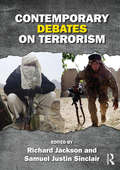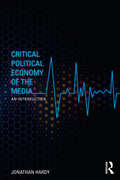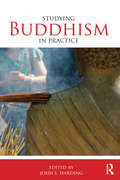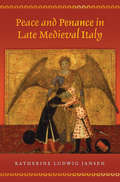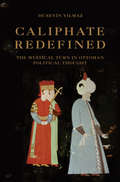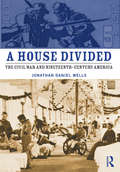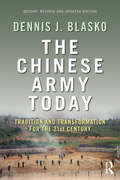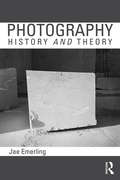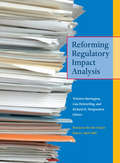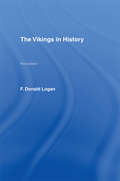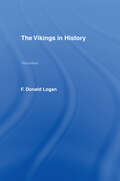- Table View
- List View
Image Studies: Theory and Practice
by Sunil ManghaniImage Studies offers an engaging introduction to visual and image studies. In order to better understand images and visual culture the book seeks to bridge between theory and practice; asking the reader to think critically about images and image practices, but also simultaneously to make images and engage with image-makers and image-making processes. Looking across a range of domains and disciplines, we find the image is never a single, static thing. Rather, the image can be a concept, an object, a picture, or medium – and all these things combined. At the heart of this book is the idea of an ‘ecology of images’, through which we can examine the full ‘life’ of an image – to understand how an image resonates within a complex set of contexts, processes and uses. Part 1 covers theoretical perspectives on the image, supplemented with practical entries on making, researching and writing with images. Part 2 explores specific image practices and cultures, with chapters on drawing and painting; photography; visual culture; scientific imaging; and informational images. A wide range of illustrations complement the text throughout and each chapter includes creative tasks, keywords (linked to an online resource), summaries and suggested further reading. In addition, each of the main chapters include selected readings by notable authors across a range of subject areas, including: Art History, Business, Cognitive Science, Communication Studies, Infographics, Neuroscience, Photography, Physics, Science Studies, Social Semiotics, Statistics, and Visual Culture.
Image Studies: Theory and Practice
by Sunil ManghaniImage Studies offers an engaging introduction to visual and image studies. In order to better understand images and visual culture the book seeks to bridge between theory and practice; asking the reader to think critically about images and image practices, but also simultaneously to make images and engage with image-makers and image-making processes. Looking across a range of domains and disciplines, we find the image is never a single, static thing. Rather, the image can be a concept, an object, a picture, or medium – and all these things combined. At the heart of this book is the idea of an ‘ecology of images’, through which we can examine the full ‘life’ of an image – to understand how an image resonates within a complex set of contexts, processes and uses. Part 1 covers theoretical perspectives on the image, supplemented with practical entries on making, researching and writing with images. Part 2 explores specific image practices and cultures, with chapters on drawing and painting; photography; visual culture; scientific imaging; and informational images. A wide range of illustrations complement the text throughout and each chapter includes creative tasks, keywords (linked to an online resource), summaries and suggested further reading. In addition, each of the main chapters include selected readings by notable authors across a range of subject areas, including: Art History, Business, Cognitive Science, Communication Studies, Infographics, Neuroscience, Photography, Physics, Science Studies, Social Semiotics, Statistics, and Visual Culture.
An Introduction to Television Studies
by Jonathan BignellIn this comprehensive textbook, now updated for its third edition, Jonathan Bignell provides students with a framework for understanding the key concepts and main approaches to Television Studies, including audience research, television history and broadcasting policy, and the analytical study of individual programmes. Features include: a glossary of key terms key terms defined in margins suggestions for further reading activities/assignments for use in class New and updated case studies feature: ‘Every Home Needs a Harvey’ ad approaches to news reporting television scheduling CSI Crime Scene Investigation animated cartoon series Individual chapters address: studying television, television histories, television cultures, television texts and narratives, television genres and formats, television production, television and quality, television realities, television you can’t see, television audiences, beyond television.
An Introduction to Television Studies
by Jonathan BignellIn this comprehensive textbook, now updated for its third edition, Jonathan Bignell provides students with a framework for understanding the key concepts and main approaches to Television Studies, including audience research, television history and broadcasting policy, and the analytical study of individual programmes. Features include: a glossary of key terms key terms defined in margins suggestions for further reading activities/assignments for use in class New and updated case studies feature: ‘Every Home Needs a Harvey’ ad approaches to news reporting television scheduling CSI Crime Scene Investigation animated cartoon series Individual chapters address: studying television, television histories, television cultures, television texts and narratives, television genres and formats, television production, television and quality, television realities, television you can’t see, television audiences, beyond television.
Contemporary Debates on Terrorism (PDF)
by Richard Jackson Samuel Justin SinclairContemporary Debates on Terrorism is an innovative new textbook, addressing a number of key issues in contemporary terrorism studies from both 'traditional' and 'critical' perspectives. In recent years the terrorism studies field has grown significantly, with an increasing number of scholars beginning to debate the complex dynamics underlying this category of violence. Within the broader field, there are many identifiable controversies and issues which divide scholarly opinion, a number of which are discussed in this text: Theoretical issues, such as the definition of terrorism and state terrorism; Substantive issues, including the threat posed by al Qaeda and the utility of different responses to terrorism; Ethical issues, encompassing the torture of terrorist suspects and targeted assassination The format of the volume involves a leading scholar taking a particular position on the controversy, followed by an opposing or alternative viewpoint written by another contributor. In addition to the pedagogic value of allowing students to read opposing arguments in one place, the volume will also be important for providing an overview of the state of the field and its key lines of debate. Contemporary Debates on Terrorism will be essential reading for all students of terrorism and political violence, critical terrorism studies, critical security studies, security studies and IR in general.
Critical Political Economy of the Media: An Introduction
by Jonathan HardyHow the media are organised and funded is central to understanding their role in society. Critical Political Economy of the Media provides a clear, comprehensive and insightful introduction to the political economic analysis of contemporary media. Jonathan Hardy undertakes a critical survey of political economy scholarship encompassing worldwide literature, issues and debates, and relationships with other academic approaches. He assesses different ways of making sense of media convergence and digitalisation, media power and influence, and transformations across communication markets. Many of the problems of the media that prompted critical political economy research remain salient, he argues, but the approach must continue to adapt to new conditions and challenges. Hardy advances the case for a revitalised critical media studies for the 21st century. Topics covered include: media ownership and financing news and entertainment convergence and the Internet media globalisation advertising and media alternative media media policy and regulation Introducing key concepts and research, this book explains how political economy can assist students, researchers and citizens to investigate and address vital questions about the media today.
Critical Political Economy of the Media: An Introduction
by Jonathan HardyHow the media are organised and funded is central to understanding their role in society. Critical Political Economy of the Media provides a clear, comprehensive and insightful introduction to the political economic analysis of contemporary media. Jonathan Hardy undertakes a critical survey of political economy scholarship encompassing worldwide literature, issues and debates, and relationships with other academic approaches. He assesses different ways of making sense of media convergence and digitalisation, media power and influence, and transformations across communication markets. Many of the problems of the media that prompted critical political economy research remain salient, he argues, but the approach must continue to adapt to new conditions and challenges. Hardy advances the case for a revitalised critical media studies for the 21st century. Topics covered include: media ownership and financing news and entertainment convergence and the Internet media globalisation advertising and media alternative media media policy and regulation Introducing key concepts and research, this book explains how political economy can assist students, researchers and citizens to investigate and address vital questions about the media today.
Teaching History with Museums: Strategies for K-12 Social Studies
by Alan S. Marcus Jeremy D. Stoddard Walter W. WoodwardTeaching History with Museums provides an introduction and overview of the rich pedagogical power of museums. In this comprehensive textbook, the authors show how museums offer a sophisticated understanding of the past and develop habits of mind in ways that are not easily duplicated in the classroom. Using engaging cases to illustrate accomplished history teaching through museum visits, this text provides pre- and in-service teachers, teacher educators, and museum educators with ideas for successful visits to artifact and display-based museums, historic forts, living history museums, memorials, monuments, and other heritage sites. Each case is constructed to be adapted and tailored in ways that will be applicable to any classroom and encourage students to think deeply about museums as historical accounts and interpretations to be examined, questioned, and discussed.
Teaching History with Museums: Strategies for K-12 Social Studies
by Alan S. Marcus Jeremy D. Stoddard Walter W. WoodwardTeaching History with Museums provides an introduction and overview of the rich pedagogical power of museums. In this comprehensive textbook, the authors show how museums offer a sophisticated understanding of the past and develop habits of mind in ways that are not easily duplicated in the classroom. Using engaging cases to illustrate accomplished history teaching through museum visits, this text provides pre- and in-service teachers, teacher educators, and museum educators with ideas for successful visits to artifact and display-based museums, historic forts, living history museums, memorials, monuments, and other heritage sites. Each case is constructed to be adapted and tailored in ways that will be applicable to any classroom and encourage students to think deeply about museums as historical accounts and interpretations to be examined, questioned, and discussed.
Studying Buddhism in Practice
by John S. HardingThis book introduces the rich realities of the Buddhist tradition and the academic approaches through which they are studied. Based on personal experiences of Buddhism on the ground, it provides a reflective context within which religious practices can be understood and appreciated. The engaging narratives cover a broad range of Buddhist countries and traditions, drawing on fieldwork to explore topics such as ordination, pilgrimage, funerals, gender roles, and film-making. All the entries provide valuable contextual discussion and are accompanied by photographs and suggestions for further reading.
Studying Buddhism in Practice
by John S. HardingThis book introduces the rich realities of the Buddhist tradition and the academic approaches through which they are studied. Based on personal experiences of Buddhism on the ground, it provides a reflective context within which religious practices can be understood and appreciated. The engaging narratives cover a broad range of Buddhist countries and traditions, drawing on fieldwork to explore topics such as ordination, pilgrimage, funerals, gender roles, and film-making. All the entries provide valuable contextual discussion and are accompanied by photographs and suggestions for further reading.
The Roman World 44 BC–AD 180
by Martin GoodmanThe Roman World 44 BC – AD 180 deals with the transformation of the Mediterranean regions, northern Europe and the Near East by the military autocrats who ruled Rome during this period. The book traces the impact of imperial politics on life in the city of Rome itself and in the rest of the empire, arguing that, despite long periods of apparent peace, this was a society controlled as much by fear of state violence as by consent. Martin Goodman examines the reliance of Roman emperors on a huge military establishment and the threat of force. He analyses the extent to which the empire functioned as a single political, economic and cultural unit and discusses, region by region, how much the various indigenous cultures and societies were affected by Roman rule. The book has a long section devoted to the momentous religious changes in this period, which witnessed the popularity and spread of a series of elective cults and the emergence of rabbinic Judaism and Christianity from the complex world of first-century Judaea. This book provides a critical assessment of the significance of Roman rule for inhabitants of the empire, and introduces readers to many of the main issues currently faced by historians of the early empire. This new edition, incorporating the finds of recent scholarship, includes a fuller narrative history, expanded sections on the history of women and slaves and on cultural life in the city of Rome, many new illustrations, an updated section of bibliographical notes, and other improvements designed to make the volume as useful as possible to students as well as the general reader.
The Roman World 44 BC–AD 180
by Martin GoodmanThe Roman World 44 BC – AD 180 deals with the transformation of the Mediterranean regions, northern Europe and the Near East by the military autocrats who ruled Rome during this period. The book traces the impact of imperial politics on life in the city of Rome itself and in the rest of the empire, arguing that, despite long periods of apparent peace, this was a society controlled as much by fear of state violence as by consent. Martin Goodman examines the reliance of Roman emperors on a huge military establishment and the threat of force. He analyses the extent to which the empire functioned as a single political, economic and cultural unit and discusses, region by region, how much the various indigenous cultures and societies were affected by Roman rule. The book has a long section devoted to the momentous religious changes in this period, which witnessed the popularity and spread of a series of elective cults and the emergence of rabbinic Judaism and Christianity from the complex world of first-century Judaea. This book provides a critical assessment of the significance of Roman rule for inhabitants of the empire, and introduces readers to many of the main issues currently faced by historians of the early empire. This new edition, incorporating the finds of recent scholarship, includes a fuller narrative history, expanded sections on the history of women and slaves and on cultural life in the city of Rome, many new illustrations, an updated section of bibliographical notes, and other improvements designed to make the volume as useful as possible to students as well as the general reader.
Peace and Penance in Late Medieval Italy
by Katherine Ludwig JansenMedieval Italian communes are known for their violence, feuds, and vendettas, yet beneath this tumult was a society preoccupied with peace. Peace and Penance in Late Medieval Italy is the first book to examine how civic peacemaking in the age of Dante was forged in the crucible of penitential religious practice.Focusing on Florence in the thirteenth and fourteenth centuries, an era known for violence and civil discord, Katherine Ludwig Jansen brilliantly illuminates how religious and political leaders used peace agreements for everything from bringing an end to neighborhood quarrels to restoring full citizenship to judicial exiles. She brings to light a treasure trove of unpublished evidence from notarial archives and supports it with sermons, hagiography, political treatises, and chronicle accounts. She paints a vivid picture of life in an Italian commune, a socially and politically unstable world that strove to achieve peace. Jansen also assembles a wealth of visual material from the period, illustrating for the first time how the kiss of peace—a ritual gesture borrowed from the Catholic Mass—was incorporated into the settlement of secular disputes.Breaking new ground in the study of peacemaking in the Middle Ages, Peace and Penance in Late Medieval Italy adds an entirely new dimension to our understanding of Italian culture in this turbulent age by showing how peace was conceived, memorialized, and occasionally achieved.
Caliphate Redefined: The Mystical Turn in Ottoman Political Thought
by Hüseyin YılmazThe medieval theory of the caliphate, epitomized by the Abbasids (750–1258), was the construct of jurists who conceived it as a contractual leadership of the Muslim community in succession to the Prophet Muhammed’s political authority. In this book, Hüseyin Yilmaz traces how a new conception of the caliphate emerged under the Ottomans, who redefined the caliph as at once a ruler, a spiritual guide, and a lawmaker corresponding to the prophet’s three natures.Challenging conventional narratives that portray the Ottoman caliphate as a fading relic of medieval Islamic law, Yilmaz offers a novel interpretation of authority, sovereignty, and imperial ideology by examining how Ottoman political discourse led to the mystification of Muslim political ideals and redefined the caliphate. He illuminates how Ottoman Sufis reimagined the caliphate as a manifestation and extension of cosmic divine governance. The Ottoman Empire arose in Western Anatolia and the Balkans, where charismatic Sufi leaders were perceived to be God’s deputies on earth. Yilmaz traces how Ottoman rulers, in alliance with an increasingly powerful Sufi establishment, continuously refashioned and legitimated their rule through mystical imageries of authority, and how the caliphate itself reemerged as a moral paradigm that shaped early modern Muslim empires.A masterful work of scholarship, Caliphate Redefined is the first comprehensive study of premodern Ottoman political thought to offer an extensive analysis of a wealth of previously unstudied texts in Arabic, Persian, and Ottoman Turkish.
Caliphate Redefined: The Mystical Turn in Ottoman Political Thought
by Hüseyin YılmazThe medieval theory of the caliphate, epitomized by the Abbasids (750–1258), was the construct of jurists who conceived it as a contractual leadership of the Muslim community in succession to the Prophet Muhammed’s political authority. In this book, Hüseyin Yilmaz traces how a new conception of the caliphate emerged under the Ottomans, who redefined the caliph as at once a ruler, a spiritual guide, and a lawmaker corresponding to the prophet’s three natures.Challenging conventional narratives that portray the Ottoman caliphate as a fading relic of medieval Islamic law, Yilmaz offers a novel interpretation of authority, sovereignty, and imperial ideology by examining how Ottoman political discourse led to the mystification of Muslim political ideals and redefined the caliphate. He illuminates how Ottoman Sufis reimagined the caliphate as a manifestation and extension of cosmic divine governance. The Ottoman Empire arose in Western Anatolia and the Balkans, where charismatic Sufi leaders were perceived to be God’s deputies on earth. Yilmaz traces how Ottoman rulers, in alliance with an increasingly powerful Sufi establishment, continuously refashioned and legitimated their rule through mystical imageries of authority, and how the caliphate itself reemerged as a moral paradigm that shaped early modern Muslim empires.A masterful work of scholarship, Caliphate Redefined is the first comprehensive study of premodern Ottoman political thought to offer an extensive analysis of a wealth of previously unstudied texts in Arabic, Persian, and Ottoman Turkish.
A House Divided: The Civil War and Nineteenth-Century America
by Jonathan Daniel WellsThe Civil War is one of the most defining eras of American history, and much has been written on every aspect of the war. The volume of material available is daunting, especially when a student is trying to grasp the overall themes of the period. Jonathan Wells has distilled the war down into understandable, easy-to-read sections, with plenty of maps and illustrations, to help make sense of the battles and social, political, and cultural changes of the era. Presented here is information on: the home front the battles, both in the East and the West the status of slaves women’s role in the war and its aftermath literature and public life international aspects of the war and much more! Students will also find helpful study aids on the companion website for the book. A House Divided provides a short, readable survey of the Civil War and the Reconstruction period afterward, focusing not only on the battles, but on how Americans lived during a time of great upheaval in the country’s history, and what that legacy has meant to the country today.
A House Divided: The Civil War and Nineteenth-Century America
by Jonathan Daniel WellsThe Civil War is one of the most defining eras of American history, and much has been written on every aspect of the war. The volume of material available is daunting, especially when a student is trying to grasp the overall themes of the period. Jonathan Wells has distilled the war down into understandable, easy-to-read sections, with plenty of maps and illustrations, to help make sense of the battles and social, political, and cultural changes of the era. Presented here is information on: the home front the battles, both in the East and the West the status of slaves women’s role in the war and its aftermath literature and public life international aspects of the war and much more! Students will also find helpful study aids on the companion website for the book. A House Divided provides a short, readable survey of the Civil War and the Reconstruction period afterward, focusing not only on the battles, but on how Americans lived during a time of great upheaval in the country’s history, and what that legacy has meant to the country today.
The Chinese Army Today: Tradition and Transformation for the 21st Century
by Dennis J. BlaskoThe Chinese Army Today is a comprehensive study of the Chinese military, examining its ground forces in a level of detail not found in any other contemporary works. This new, revised edition has been fully updated to take account of recent changes in the institution. In 1999, the military modernization program of the Chinese People’s Liberation Army increased in intensity and achieved a focus not seen in the previous two decades. Based primarily on actual Chinese sources, this book details these changes and puts them in the context of the many traditions that still remain. Written by a retired professional military officer who has served in China, the text uses first-hand observation of the Chinese military and three decades of military experience to weave many disparate threads from official Chinese statements, documents, and media reports into an integrated whole. The author also conducts an in-depth exploration into the many forces that constitute the People’s Liberation Army. This is an essential book for all students of Chinese military and security affairs, and highly recommended for students of Chinese Politics, Asian Security, and International Relations and Strategic Studies, in general.
The Chinese Army Today: Tradition and Transformation for the 21st Century
by Dennis J. BlaskoThe Chinese Army Today is a comprehensive study of the Chinese military, examining its ground forces in a level of detail not found in any other contemporary works. This new, revised edition has been fully updated to take account of recent changes in the institution. In 1999, the military modernization program of the Chinese People’s Liberation Army increased in intensity and achieved a focus not seen in the previous two decades. Based primarily on actual Chinese sources, this book details these changes and puts them in the context of the many traditions that still remain. Written by a retired professional military officer who has served in China, the text uses first-hand observation of the Chinese military and three decades of military experience to weave many disparate threads from official Chinese statements, documents, and media reports into an integrated whole. The author also conducts an in-depth exploration into the many forces that constitute the People’s Liberation Army. This is an essential book for all students of Chinese military and security affairs, and highly recommended for students of Chinese Politics, Asian Security, and International Relations and Strategic Studies, in general.
Photography: History and Theory
by Jae EmerlingPhotography: History and Theory introduces students to both the history of photography and critical theory. From its inception in the nineteenth century, photography has instigated a series of theoretical debates. In this new text, Jae Emerling therefore argues that the most insightful way to approach the histories of photography is to address simultaneously the key events of photographic history alongside the theoretical discourse that accompanied them. While the nineteenth century is discussed, the central focus of the text is on modern and contemporary photographic theory. Particular attention is paid to key thinkers, such as Baudelaire, Barthes and Sontag. In addition, the centrality of photography to contemporary art practice is addressed through the theoretical work of Allan Sekula, John Tagg, Rosalind Krauss, and Vilém Flusser. The text also includes readings of many canonical photographers and exhibitions including: Atget, Brassai, August Sander, Walker Evans, The Family of Man, Diane Arbus, Lee Friedlander, Cindy Sherman, Bernd and Hilla Becher, Sebastaio Salgado, Jeff Wall, and others. In addition, Emerling provides close readings of key passages from some major theoretical texts. These glosses come between the chapters and serve as a conceptual line that connects them. Glosses include: Roland Barthes, "The Rhetoric of the Image" (1964) Susan Sontag, Regarding the Pain of Others (2002) Michel Foucault on the archive (1969) Walter Benjamin, "Little History of Photography" (1931) Vilém Flusser, Towards a Philosophy of Photography (1983) A substantial glossary of critical terms and names, as well as an extensive bibliography, make this the ideal book for courses on the history and theory of photography.
Reforming Regulatory Impact Analysis
by Winston Harrington Lisa Heinzerling Richard D MorgensternOver the past decades, considerable debate has emerged surrounding the use of cost-benefit analysis (CBA) to analyze and make recommendations for environmental and safety regulations. Critics argue that CBA forces values on unquantifiable factors, that it does not adequately measure benefits across generations, and that it is not adaptable in situations of uncertainty. Proponents, on the other hand, believe that a well-done CBA provides useful, albeit imperfect, information to policymakers precisely because of the standard metrics that are applied across the analysis. Largely absent from the debate have been practical questions about how the use of CBA could be improved. Relying on the assumption that CBA will remain an important component in the regulatory process, this new work from Resources for the Future brings together experts representing both sides of the debate to analyze the use of CBA in three key case studies: the Clean Air Interstate Rule, the Clean Air Mercury Rule, and the Cooling Water Intake Structure Rule (Phase II). Each of the case studies is accompanied by critiques from both an opponent and a proponent of CBA and includes consideration of complementary analyses that could have been employed. The work's editors - two CBA supporters and one critic - conclude the report by offering concrete recommendations for improving the use of CBA, focusing on five areas: technical quality of the analyses, relevance to the agency decision-making process, transparency of the analyses, treatment of new scientific findings, and balance in both the analyses and associated processes, including the treatment of distributional consequences.
Reforming Regulatory Impact Analysis
by Winston Harrington Lisa Heinzerling Richard D MorgensternOver the past decades, considerable debate has emerged surrounding the use of cost-benefit analysis (CBA) to analyze and make recommendations for environmental and safety regulations. Critics argue that CBA forces values on unquantifiable factors, that it does not adequately measure benefits across generations, and that it is not adaptable in situations of uncertainty. Proponents, on the other hand, believe that a well-done CBA provides useful, albeit imperfect, information to policymakers precisely because of the standard metrics that are applied across the analysis. Largely absent from the debate have been practical questions about how the use of CBA could be improved. Relying on the assumption that CBA will remain an important component in the regulatory process, this new work from Resources for the Future brings together experts representing both sides of the debate to analyze the use of CBA in three key case studies: the Clean Air Interstate Rule, the Clean Air Mercury Rule, and the Cooling Water Intake Structure Rule (Phase II). Each of the case studies is accompanied by critiques from both an opponent and a proponent of CBA and includes consideration of complementary analyses that could have been employed. The work's editors - two CBA supporters and one critic - conclude the report by offering concrete recommendations for improving the use of CBA, focusing on five areas: technical quality of the analyses, relevance to the agency decision-making process, transparency of the analyses, treatment of new scientific findings, and balance in both the analyses and associated processes, including the treatment of distributional consequences.
The Vikings in History
by F. Donald LoganCompletely updated to include important primary research, archaeological findings and debates from the last decade, this third edition of F. Donald Logan's successful book examines the Vikings and their critical role in history. The author uses archaeological, literary and historical evidence to analyze the Vikings' overseas expeditions and their transformation from raiders to settlers. Focusing on the period from 800–1050, it studies the Vikings across the world, from Denmark and Sweden right across to the British Isles, the North Atlantic and the New World. This edition includes: a new epilogue explaining the aims of the book updated further reading sections maps and photographs. By taking this new archaeological and primary research into account, the author provides a vital text for history students and researchers of this fascinating people.
The Vikings in History
by F. Donald LoganCompletely updated to include important primary research, archaeological findings and debates from the last decade, this third edition of F. Donald Logan's successful book examines the Vikings and their critical role in history. The author uses archaeological, literary and historical evidence to analyze the Vikings' overseas expeditions and their transformation from raiders to settlers. Focusing on the period from 800–1050, it studies the Vikings across the world, from Denmark and Sweden right across to the British Isles, the North Atlantic and the New World. This edition includes: a new epilogue explaining the aims of the book updated further reading sections maps and photographs. By taking this new archaeological and primary research into account, the author provides a vital text for history students and researchers of this fascinating people.




